Demand-Side Optimal Sizing of a Solar Energy–Biomass Hybrid System for Isolated Greenhouse Environments: Methodology and Application Example
Abstract
:1. Introduction
- A demand-side optimal sizing algorithm composed of two layers is presented. The upper layer performs the design, based on a global optimization algorithm that attempts to maximize the solar energy contribution in the hybrid system. Unlike the approach presented in [26], the optimization problem is formulated as a single-objective problem with an operational constraint that prevents the key elements, such as the solar field, from being oversized. The approach itself facilitates its applicability since no setting parameters need to be tuned.On the other hand, the lower layer is responsible for evaluating the operation of the hybrid system from the sizing parameters provided by the upper layer and sending the results back to the same one; hence, they are in continuous communication until the optimization algorithm converges to the global solution of the problem. Therefore, the algorithm offers a solution that integrates both the operation of the system over the period of time considered and the optimal design of its sizing parameters.
- The Energy Hubs (EH) [27] approach is proposed to link the two aforementioned layers. This broad methodology allows one to build a model that represents energy and mass balances between certain input resources that can be converted into other output resources. Each component of the system is usually characterized by static or time-variant conversion factors, thus, considerably decreasing the computational burden of the problem. A complete EH model for these kinds of systems is proposed, and the way in which these models are related to the sizing parameters provided by the optimization technique is depicted. This type of modelling methodology is justified as long as an effective low-level controller is implemented in the systems under study, which was addressed in previous studies [28,29] for the solar thermal field and biomass system, respectively.
- A case study in the province of Almería (Southeast Spain) is presented to illustrate the performance of the proposed methodology. In this case study, a full year of data on an hourly basis was used for design. The results obtained are analysed in operating and economic terms demonstrating and validating the good performance of the proposed methodology. The province of Almería is a region of special interest since, on the one hand, its main economic driving force is agriculture based on greenhouse crop production [30,31], and, on the other, it has a wide availability of solar energy, which makes the implementation of solar-based technologies viable.In addition, this province is the perfect illustration of the relevance of the WEF nexus in the situation where there are trade-offs between (1) the production of high-quality products that supply a large part of Europe with healthy food, (2) a development model that has turned the poorest province in Spain into a reasonably equitable cooperative agricultural model, and (3) huge stress on the water resources and aquifers as well as problems with dealing with nitrate directives and controlling greenhouse expansion. Thus, the solution offered by this paper is part of the puzzle of the transitioning agricultural systems into more sustainable pathways.
2. Hybrid Plant Description and Modeling
2.1. Plant Description
2.2. Model of the Hybrid System
2.3. Performance Indicators
3. Design Optimization Method
3.1. Operational Layer: Thermal Demand Calculation
3.2. Operational Layer: Rule-Based Control System of the Hybrid System
- If the solar irradiance is higher than a threshold value, the solar field is turned on and the energy provided by this system is used to cover the demand.
- If the energy provided is higher than the demand, the surplus is stored in the storage system.
- Otherwise, either the remaining energy in the thermal storage tank (if any) is used to cover the demand or, if not, the biomass boiler is used instead.
3.3. Sizing Layer: Optimization Problem Statement
4. Results and Discussion
4.1. Optimal Design
4.2. Optimized Plant Performance
4.3. Analysis of the Optimal Solution
5. Conclusions
- The proposed algorithm resulted in a powerful tool to carry out demand-side design of solar-biomass hybrid systems for greenhouse environments. Its use is especially recommended for applications where the demand is heterogeneous, such as for the case study conducted. There was a high demand for heating during the winter months and a more homogeneous demand during the rest of the year due to the thermal consumption of the desalination plant used to provide the irrigation water.
- The use of the EH modelling methodology was proven to be an effective mechanism for bridging the design and operation phases. This methodology allowed us to evaluate, in a simple and fast way, each of the designs proposed by the optimization algorithm during a full year of operation. This resulted in a much more adequate design of the system and avoided the oversizing of key elements for the economic profitability of the system, such as the solar field and the thermal storage tank.
- Regarding the case study, the results revealed an optimal solar fraction for the considered location (Almería province) and greenhouse size (1 ha) of 16%. With this solar fraction, the system was able to cover almost the complete thermal demand of the desalination facility during hot months where there was no heat demand from the greenhouse.
- Finally, the economic evaluation performed in terms of the LCOH and discount payback period confirmed the adequacy and viability of the solution provided by the design algorithm, especially for isolated areas where the price of conventional sources can be relatively high due to transportation issues.
Author Contributions
Funding
Institutional Review Board Statement
Informed Consent Statement
Data Availability Statement
Acknowledgments
Conflicts of Interest
Abbreviations
| BF | Biomass Fraction |
| CF | Cash flow |
| EH | Energy Hubs |
| HV | Heating Value |
| LCOE | Levelized Cost of Energy |
| LCOH | Levelized Cost of Heat |
| MD | Membrane Distillation |
| PSA | Plataforma Solar de Almería (Solar Platform of Almeria) |
| SF | Solar Fraction |
| STEC | Specific thermal energy consumption |
| TMY | Typical Meteorological Year |
Appendix A
Nomenclature
| Variable | Description | Units |
|---|---|---|
| A | Area | m |
| Biomass fraction | - | |
| Biomass power utilization index | - | |
| C | Cost | € |
| c | Specific heat | J/kg K |
| Cash flow | € | |
| Incident irradiance on a tilted surface | W/m | |
| Heating value | Wh/kg | |
| Absolute humidity | kg/kg | |
| Relative humidity | % | |
| I | Radiant power received by the solar field | W |
| L | Lower bound of the decision variables in the optimization problem | - |
| LCOH | Levelized Cost of Heat | €/kWh |
| k | Discrete instant time | - |
| M | Water mass flux | kg/ms |
| Flow rate | kg/h | |
| N | Useful life of the system | years |
| p | Number of samples used in the optimization procedure | - |
| Q | Heat | Wh |
| Heat flow rate | W | |
| Heat flux | W/m | |
| r | Discount rate | - |
| Solar fraction | - | |
| Specific thermal energy consumption | kWh/m | |
| T | Temperature | °C |
| U | Upper bound of the decision variables in the optimization problem | - |
| V | Velocity | m/s |
| v | Volume | m |
| Thermal loss parameter 1 of the solar field | W/(mK) | |
| Thermal loss parameter 2 of the solar field | W/(mK) | |
| Conversion factor to pass from Wh to kWh | 10 kWh/Wh | |
| Conversion factor to pass from kWh to Ws | 6 Ws/kWh | |
| Efficiency | - | |
| Density | kg/m |
| Subscripts and Superscripts | Description |
|---|---|
| A | Ambient |
| a | Greenhouse internal air |
| B | Biomass |
| b | Boiler |
| Biomass boiler | |
| Charge | |
| Convection flux | |
| Conduction flux | |
| D | Desalination plant |
| Discharge | |
| e | Greenhouse external conditions |
| g | Greenhouse |
| Heating system | |
| Inlet solar field temperature | |
| Investment | |
| Thermal losses in the storage tank | |
| M | Maintenance |
| Maximum | |
| O | Operation |
| o | Related to the solar collector optical efficiency |
| Set-point | |
| s | Storage |
| Solar field | |
| Soil surface | |
| Solar absorption | |
| Related to the savings obtained with the solar-biomass system | |
| Referred to the total thermal energy demand of the system | |
| Transpiration of the crop | |
| Ventilation flux | |
| w | Wind |
| Water |
References
- Irabien, A.; Darton, R. Energy–water–food nexus in the Spanish greenhouse tomato production. Clean Technol. Environ. Policy 2016, 18, 1307–1316. [Google Scholar] [CrossRef]
- Martinez, P.; Blanco, M.; Castro-Campos, B. The water–energy–food nexus: A fuzzy-cognitive mapping approach to support nexus-compliant policies in Andalusia (Spain). Water 2018, 10, 664. [Google Scholar] [CrossRef] [Green Version]
- Aquastat, F. Information System on Water and Agriculture. Available online: http://www.fao.org/aquastat/en/overview/methodology/water-use (accessed on 9 June 2021).
- Velasco-Muñoz, J.F.; Aznar-Sánchez, J.A.; Belmonte-Ureña, L.J.; Román-Sánchez, I.M. Sustainable water use in agriculture: A review of worldwide research. Sustainability 2018, 10, 1084. [Google Scholar] [CrossRef] [Green Version]
- Hipólito-Valencia, B.J.; Mosqueda-Jiménez, F.W.; Barajas-Fernández, J.; Ponce-Ortega, J.M. Incorporating a seawater desalination scheme in the optimal water use in agricultural activities. Agric. Water Manag. 2021, 244, 106552. [Google Scholar] [CrossRef]
- Mehmood, A.; Ren, J. Renewable energy-driven desalination for more water and less carbon. In Renewable-Energy-Driven Future; Elsevier: Amsterdam, The Netherlands, 2021; pp. 333–372. [Google Scholar]
- Aznar-Sánchez, J.A.; Belmonte-Ureña, L.J.; Velasco-Muñoz, J.F.; Valera, D.L. Farmers’ profiles and behaviours toward desalinated seawater for irrigation: Insights from South-east Spain. J. Clean. Prod. 2021, 296, 126568. [Google Scholar] [CrossRef]
- Quist-Jensen, C.A.; Macedonio, F.; Drioli, E. Membrane technology for water production in agriculture: Desalination and wastewater reuse. Desalination 2015, 364, 17–32. [Google Scholar] [CrossRef]
- Gil, J.D.; Roca, L.; Berenguel, M. Modelling and automatic control in solar membrane distillation: Fundamentals and proposals for its technological development. Rev. Iberoam. Autom. Inform. Ind. 2020, 17, 329–343. [Google Scholar] [CrossRef]
- Gil, J.D.; Álvarez, J.D.; Roca, L.; Sánchez-Molina, J.; Berenguel, M.; Rodríguez, F. Optimal thermal energy management of a distributed energy system comprising a solar membrane distillation plant and a greenhouse. Energy Convers. Manag. 2019, 198, 111791. [Google Scholar] [CrossRef]
- Bouchrit, R.; Boubakri, A.; Hafiane, A.; Bouguecha, S.A.T. Direct contact membrane distillation: Capability to treat hyper-saline solution. Desalination 2015, 376, 117–129. [Google Scholar] [CrossRef]
- Deshmukh, A.; Boo, C.; Karanikola, V.; Lin, S.; Straub, A.P.; Tong, T.; Warsinger, D.M.; Elimelech, M. Membrane distillation at the water-energy nexus: Limits, opportunities, and challenges. Energy Environ. Sci. 2018, 11, 1177–1196. [Google Scholar] [CrossRef]
- Aschilean, I.; Rasoi, G.; Raboaca, M.S.; Filote, C.; Culcer, M. Design and concept of an energy system based on renewable sources for greenhouse sustainable agriculture. Energies 2018, 11, 1201. [Google Scholar] [CrossRef] [Green Version]
- Esen, M.; Yuksel, T. Experimental evaluation of using various renewable energy sources for heating a greenhouse. Energy Build. 2013, 65, 340–351. [Google Scholar] [CrossRef]
- Taki, M.; Rohani, A.; Rahmati-Joneidabad, M. Solar thermal simulation and applications in greenhouse. Inf. Process. Agric. 2018, 5, 83–113. [Google Scholar] [CrossRef]
- Shekarchi, N.; Shahnia, F. A comprehensive review of solar-driven desalination technologies for off-grid greenhouses. Int. J. Energy Res. 2019, 43, 1357–1386. [Google Scholar] [CrossRef]
- Attar, I.; Naili, N.; Khalifa, N.; Hazami, M.; Farhat, A. Parametric and numerical study of a solar system for heating a greenhouse equipped with a buried exchanger. Energy Convers. Manag. 2013, 70, 163–173. [Google Scholar] [CrossRef]
- Lazaar, M.; Bouadila, S.; Kooli, S.; Farhat, A. Comparative study of conventional and solar heating systems under tunnel Tunisian greenhouses: Thermal performance and economic analysis. Sol. Energy 2015, 120, 620–635. [Google Scholar] [CrossRef]
- Attar, I.; Farhat, A. Efficiency evaluation of a solar water heating system applied to the greenhouse climate. Sol. Energy 2015, 119, 212–224. [Google Scholar] [CrossRef]
- Zhang, C.; Sun, J.; Lubell, M.; Qiu, L.; Kang, K. Design and simulation of a novel hybrid solar-biomass energy supply system in northwest China. J. Clean. Prod. 2019, 233, 1221–1239. [Google Scholar] [CrossRef]
- Bilandzija, N.; Voca, N.; Jelcic, B.; Jurisic, V.; Matin, A.; Grubor, M.; Kricka, T. Evaluation of Croatian agricultural solid biomass energy potential. Renew. Sustain. Energy Rev. 2018, 93, 225–230. [Google Scholar] [CrossRef]
- Morone, P.; Falcone, P.M.; Tartiu, V.E. Food waste valorisation: Assessing the effectiveness of collaborative research networks through the lenses of a COST action. J. Clean. Prod. 2019, 238, 117868. [Google Scholar] [CrossRef]
- Garcia-Herrero, I.; Hoehn, D.; Margallo, M.; Laso, J.; Bala, A.; Batlle-Bayer, L.; Fullana, P.; Vazquez-Rowe, I.; Gonzalez, M.; Durá, M.; et al. On the estimation of potential food waste reduction to support sustainable production and consumption policies. Food Policy 2018, 80, 24–38. [Google Scholar] [CrossRef]
- Ng, W.J.; Xiao, K.; Tyagi, V.K.; Pan, C.; Poh, L.S. Food Waste and Biomass Recovery. In Oxford Research Encyclopedia of Environmental Science; Oxford University Press: Oxford, UK, 2019. [Google Scholar]
- Despoudi, S.; Bucatariu, C.; Otles, S.; Kartal, C. Food waste management, valorization, and sustainability in the food industry. In Food Waste Recovery; Academic Press: Cambridge, MA, USA, 2021; pp. 3–19. [Google Scholar]
- Tilahun, F.B.; Bhandari, R.; Mamo, M. Design optimization of a hybrid solar-biomass plant to sustainably supply energy to industry: Methodology and case study. Energy 2021, 220, 119736. [Google Scholar] [CrossRef]
- Geidl, M.; Koeppel, G.; Favre-Perrod, P.; Klöckl, B.; Andersson, G.; Fröhlich, K. Energy hubs for the future. IEEE Power Energy Mag. 2006, 5, 24–30. [Google Scholar] [CrossRef]
- Gil, J.D.; Roca, L.; Zaragoza, G.; Normey-Rico, J.E.; Berenguel, M. Hierarchical control for the start-up procedure of solar thermal fields with direct storage. Control Eng. Pract. 2020, 95, 104254. [Google Scholar] [CrossRef] [Green Version]
- Sánchez-Molina, J.; Reinoso, J.; Acién, F.; Rodríguez, F.; López, J. Development of a biomass-based system for nocturnal temperature and diurnal CO2 concentration control in greenhouses. Biomass Bioenergy 2014, 67, 60–71. [Google Scholar] [CrossRef]
- Herranz de Rafael, G.; Fernández-Prados, J.S. Intensive agriculture, marketing and social structure: The case of South-eastern Spain. Agric. Econ. 2018, 64, 367–377. [Google Scholar]
- Valera, D.; Belmonte, L.; Molina, F.; López, A. Greenhouse Agriculture in Almería: A Comprehensive Techno-Economic Analysis; Cajamar: Almería, Spain, 2016. [Google Scholar]
- Ruiz-Aguirre, A.; Andrés-Mañas, J.; Fernández-Sevilla, J.; Zaragoza, G. Comparative characterization of three commercial spiral-wound membrane distillation modules. Desalin. Water Treat. 2017, 61, 152–159. [Google Scholar]
- Zaragoza, G.; Ruiz-Aguirre, A.; Guillén-Burrieza, E. Efficiency in the use of solar thermal energy of small membrane desalination systems for decentralized water production. Appl. Energy 2014, 130, 491–499. [Google Scholar] [CrossRef]
- Vallios, I.; Tsoutsos, T.; Papadakis, G. Design of biomass district heating systems. Biomass Bioenergy 2009, 33, 659–678. [Google Scholar] [CrossRef]
- Allouhi, A.; Agrouaz, Y.; Amine, M.B.; Rehman, S.; Buker, M.; Kousksou, T.; Jamil, A.; Benbassou, A. Design optimization of a multi-temperature solar thermal heating system for an industrial process. Appl. Energy 2017, 206, 382–392. [Google Scholar] [CrossRef]
- Duffie, J.A.; Beckman, W.A. Solar Engineering of Thermal Processes; John Wiley & Sons, Inc.: Hoboken, NJ, USA, 2013. [Google Scholar] [CrossRef]
- Ali, B. Techno-economic optimization for the design of solar chimney power plants. Energy Convers. Manag. 2017, 138, 461–473. [Google Scholar] [CrossRef]
- Rodríguez, F.; Berenguel, M.; Guzmán, J.L.; Ramírez-Arias, A. Modeling and Control of Greenhouse Crop Growth; Springer: Berlin/Heidelberg, Germany, 2015. [Google Scholar]
- Gil, J.D.; Ruiz-Aguirre, A.; Roca, L.; Zaragoza, G.; Berenguel, M. Prediction models to analyse the performance of a commercial-scale membrane distillation unit for desalting brines from RO plants. Desalination 2018, 445, 15–28. [Google Scholar] [CrossRef] [Green Version]
- Golberg, D.E. Genetic Algorithms in Search, Optimization, and Machine Learning; Addion Wesley: Boston, MA, USA, 1989; Volume 1989, p. 36. [Google Scholar]
- Galdeano-Gómez, E.; Aznar-Sánchez, J.A.; Pérez-Mesa, J.C. Sustainability dimensions related to agricultural-based development: The experience of 50 years of intensive farming in Almería (Spain). Int. J. Agric. Sustain. 2013, 11, 125–143. [Google Scholar] [CrossRef]
- Shamshiri, R.R.; Jones, J.W.; Thorp, K.R.; Ahmad, D.; Che Man, H.; Taheri, S. Review of optimum temperature, humidity, and vapour pressure deficit for microclimate evaluation and control in greenhouse cultivation of tomato: A review. Int. Agrophys. 2018, 32, 287–302. [Google Scholar] [CrossRef]
- EUBIA. European Biomass Industry Association. Biomass Characteristics. 2021. Available online: https://www.eubia.org/cms/wiki-biomass/biomass-characteristics-2/ (accessed on 28 April 2021).
- BOE. Certification of Solar Collectors SOLARIS CP1—NOVA. 2014. Available online: https://www.boe.es/boe/dias/2014/07/02/pdfs/BOE-A-2014-6950.pdf (accessed on 28 April 2021).
- Evins, R. Multi-level optimization of building design, energy system sizing and operation. Energy 2015, 90, 1775–1789. [Google Scholar] [CrossRef]
- Ruiz-Aguirre, A.; Andrés-Mañas, J.; Fernández-Sevilla, J.; Zaragoza, G. Experimental characterization and optimization of multi-channel spiral wound air gap membrane distillation modules for seawater desalination. Sep. Purif. Technol. 2018, 205, 212–222. [Google Scholar] [CrossRef]
- Remund, J.; Muller, S.; Kunz, S.; Huguenin-Landl, B.; Studer, C.; Cattin, R. Global Meteorological Database Version 7 Software and Data for Engineers, Planers and Education; Genossenschaft Meteotest: Bern, Switzerland, 2017; pp. 1–17. [Google Scholar]
- RIA. Red de Información Agroclimática de Andalucía. 2021. Available online: https://www.juntadeandalucia.es/agriculturaypesca/ifapa/riaweb/web/inicio_estaciones (accessed on 28 April 2021).
- MATLAB. MATLAB Optimization Toolbox Release 2020b; The MathWorks: Natick, MA, USA, 2020. [Google Scholar]
- Meyers, S.; Schmitt, B.; Vajen, K. A Comparative Cost Assessment of Low Carbon Process Heat between Solar Thermal and Heat Pumps. In Proceedings of the ISES Solar World Congress 2017, Abu Dhabi, United Arab Emirates, 29 October–2 November 2017. [Google Scholar]
- Chau, J.; Sowlati, T.; Sokhansanj, S.; Preto, F.; Melin, S.; Bi, X. Economic sensitivity of wood biomass utilization for greenhouse heating application. Appl. Energy 2009, 86, 616–621. [Google Scholar] [CrossRef]
- Ramos-Teodoro, J.; Gil, J.D.; Roca, L.; Rodríguez, F.; Berenguel, M. Optimal Water Management in Agro-Industrial Districts: An Energy Hub’s Case Study in the Southeast of Spain. Processes 2021, 9, 333. [Google Scholar] [CrossRef]
- Semple, L.; Carriveau, R.; Ting, D.S.K. A techno-economic analysis of seasonal thermal energy storage for greenhouse applications. Energy Build. 2017, 154, 175–187. [Google Scholar] [CrossRef]
- Tian, Z.; Perers, B.; Furbo, S.; Fan, J. Thermo-economic optimization of a hybrid solar district heating plant with flat plate collectors and parabolic trough collectors in series. Energy Convers. Manag. 2018, 165, 92–101. [Google Scholar] [CrossRef] [Green Version]
- Soltero, V.; Chacartegui, R.; Ortiz, C.; Velázquez, R. Potential of biomass district heating systems in rural areas. Energy 2018, 156, 132–143. [Google Scholar] [CrossRef]
- Eurostat. Natural Gas Price Statistics. 2020. Available online: https://ec.europa.eu/eurostat/statistics-explained/index.php?title=Natural_gas_price_statistics (accessed on 9 June 2021).
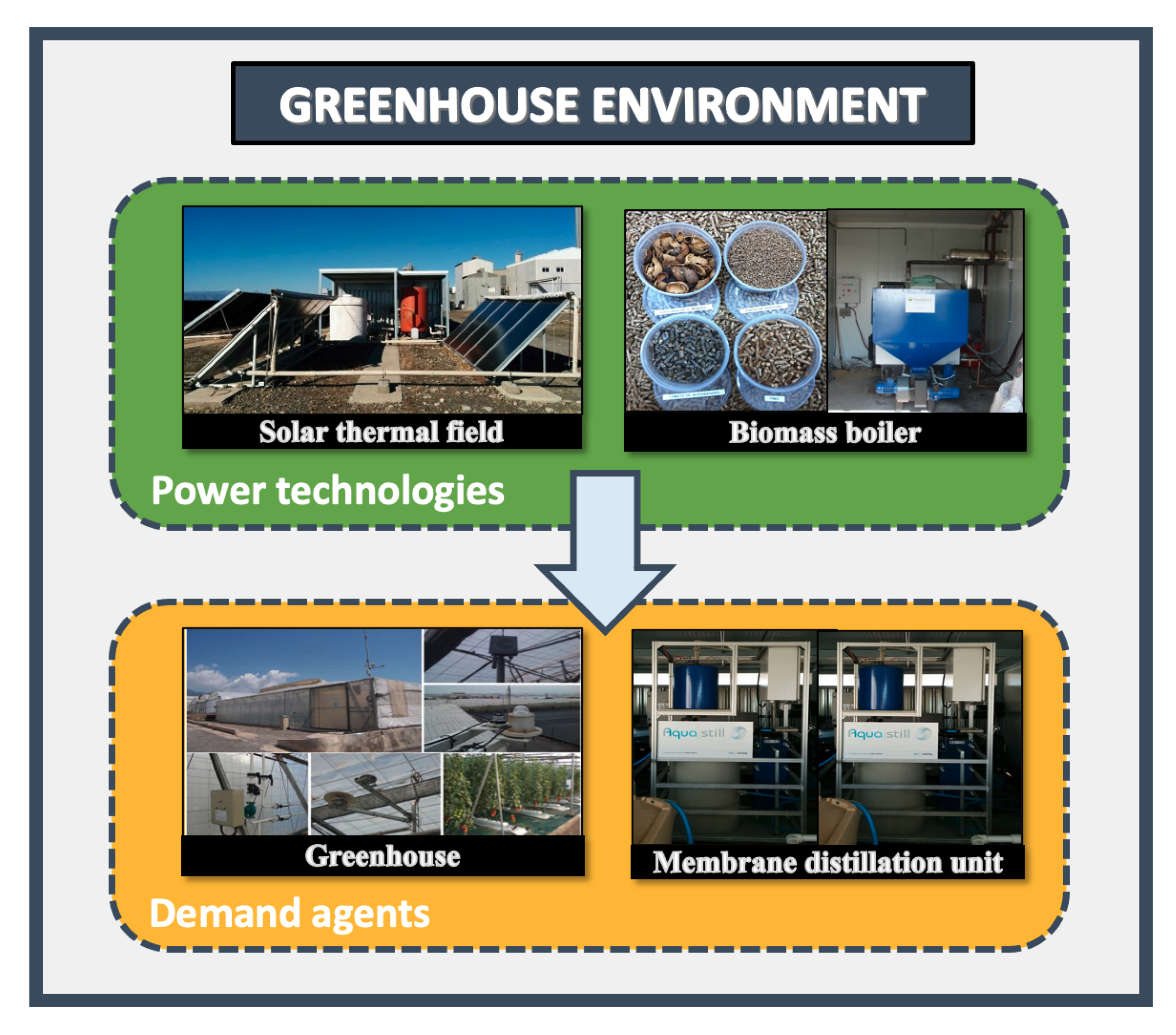
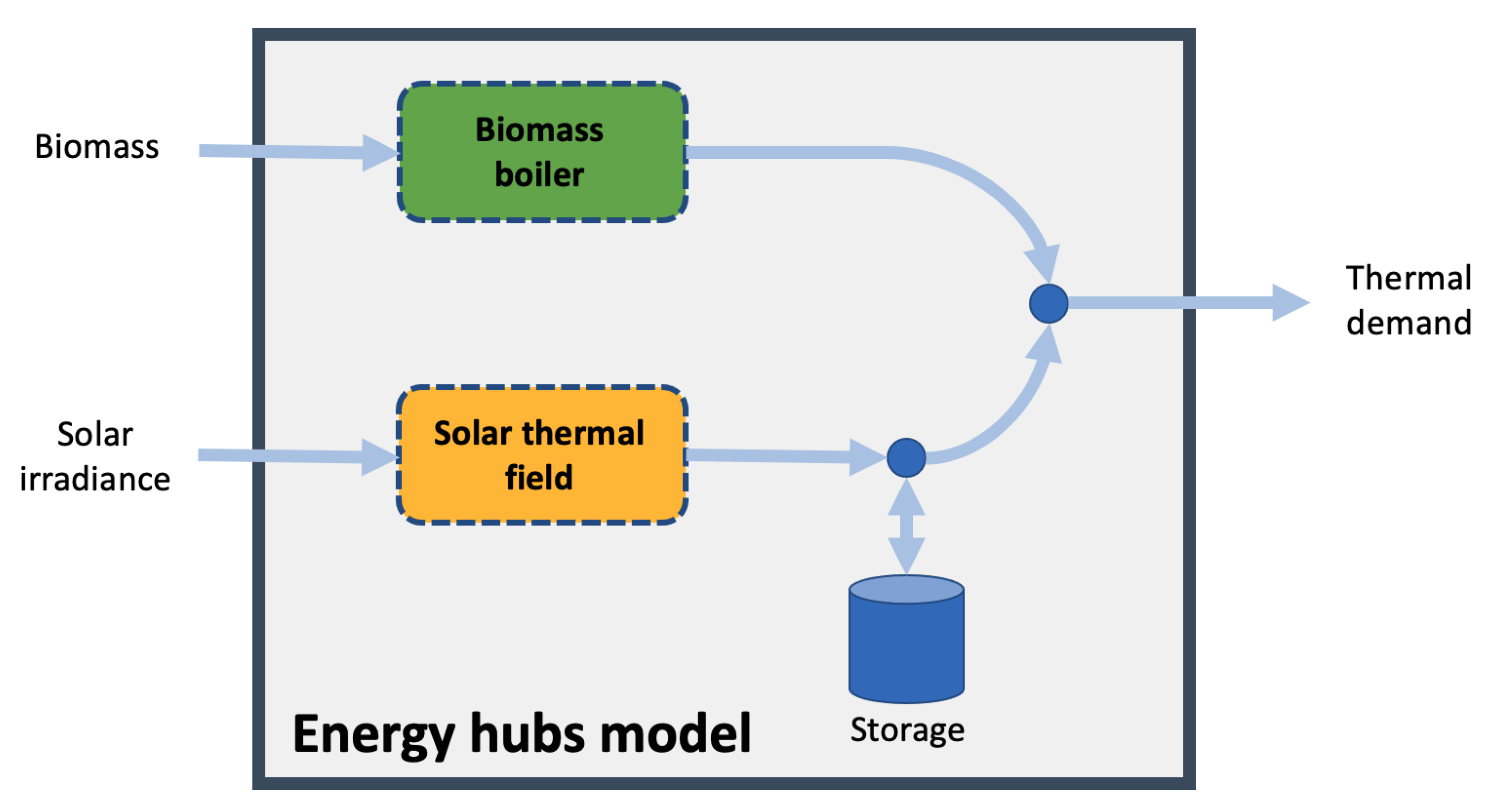
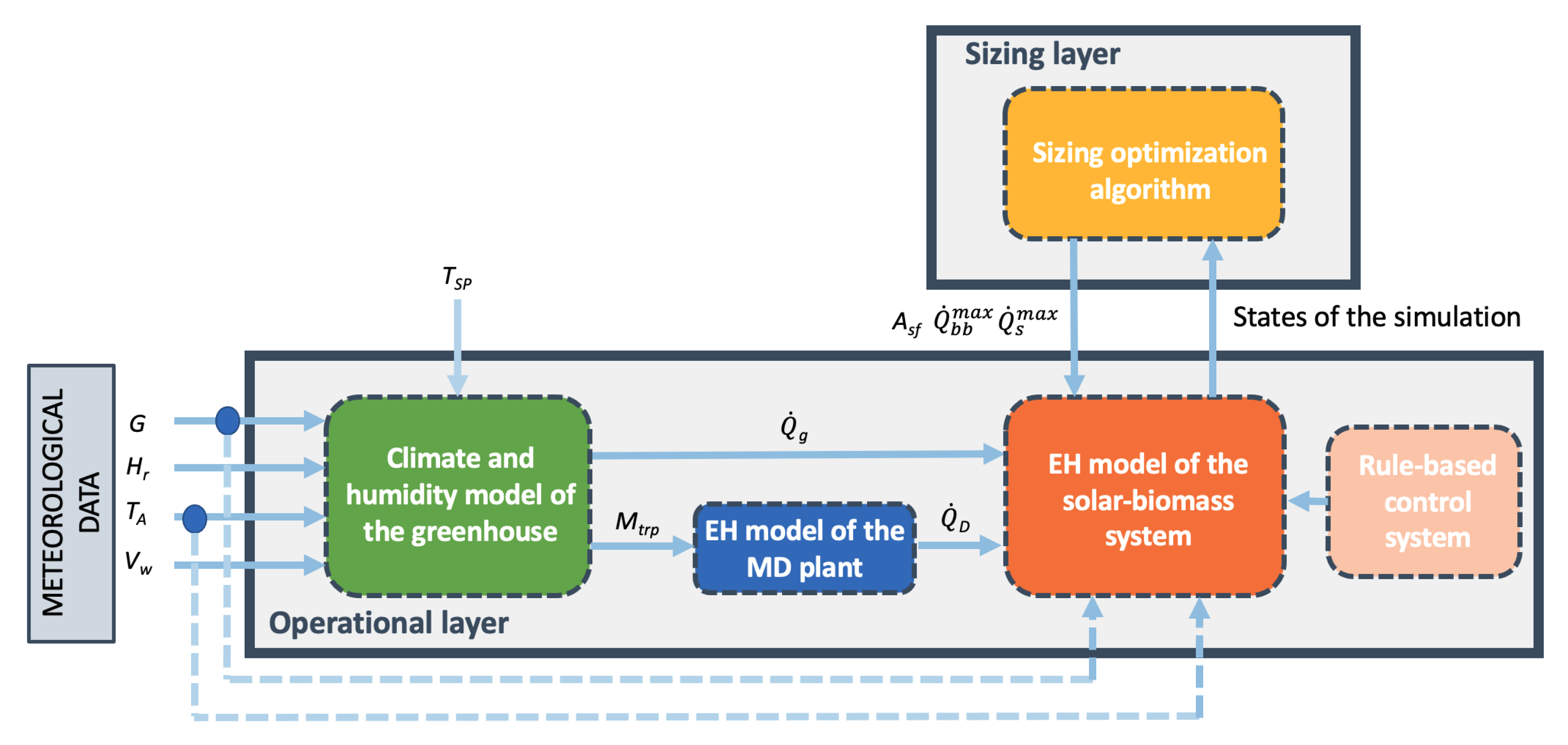
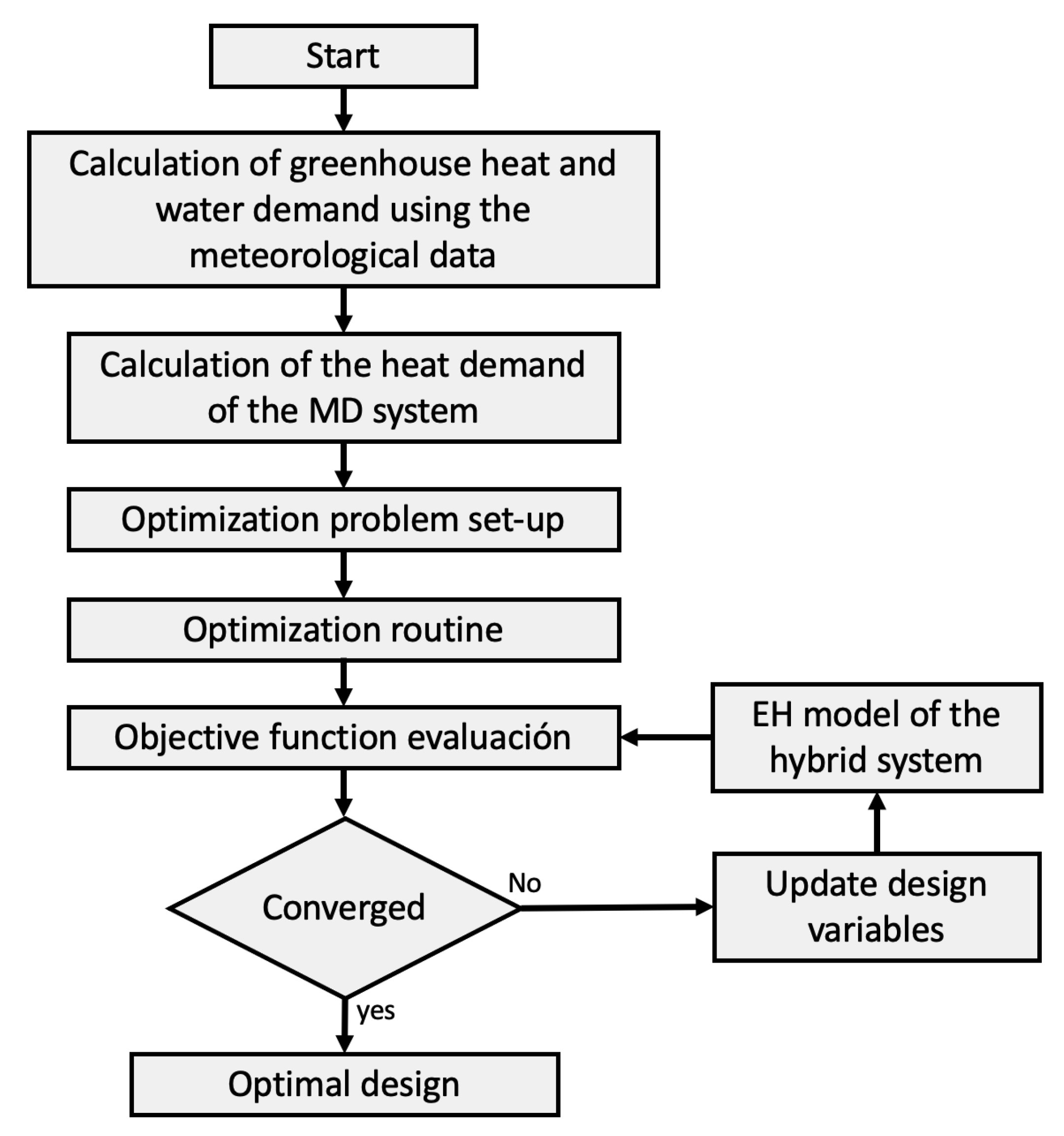
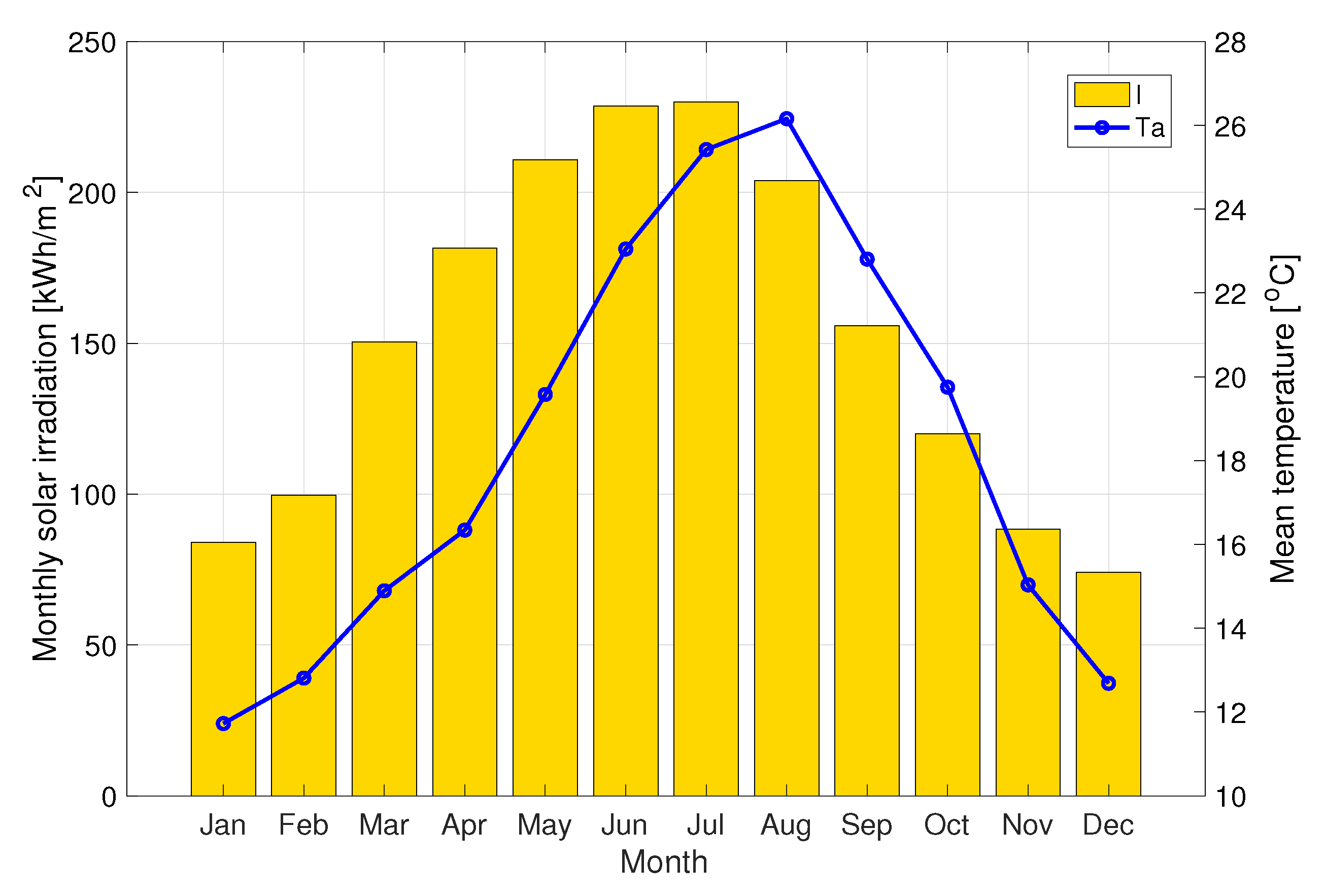


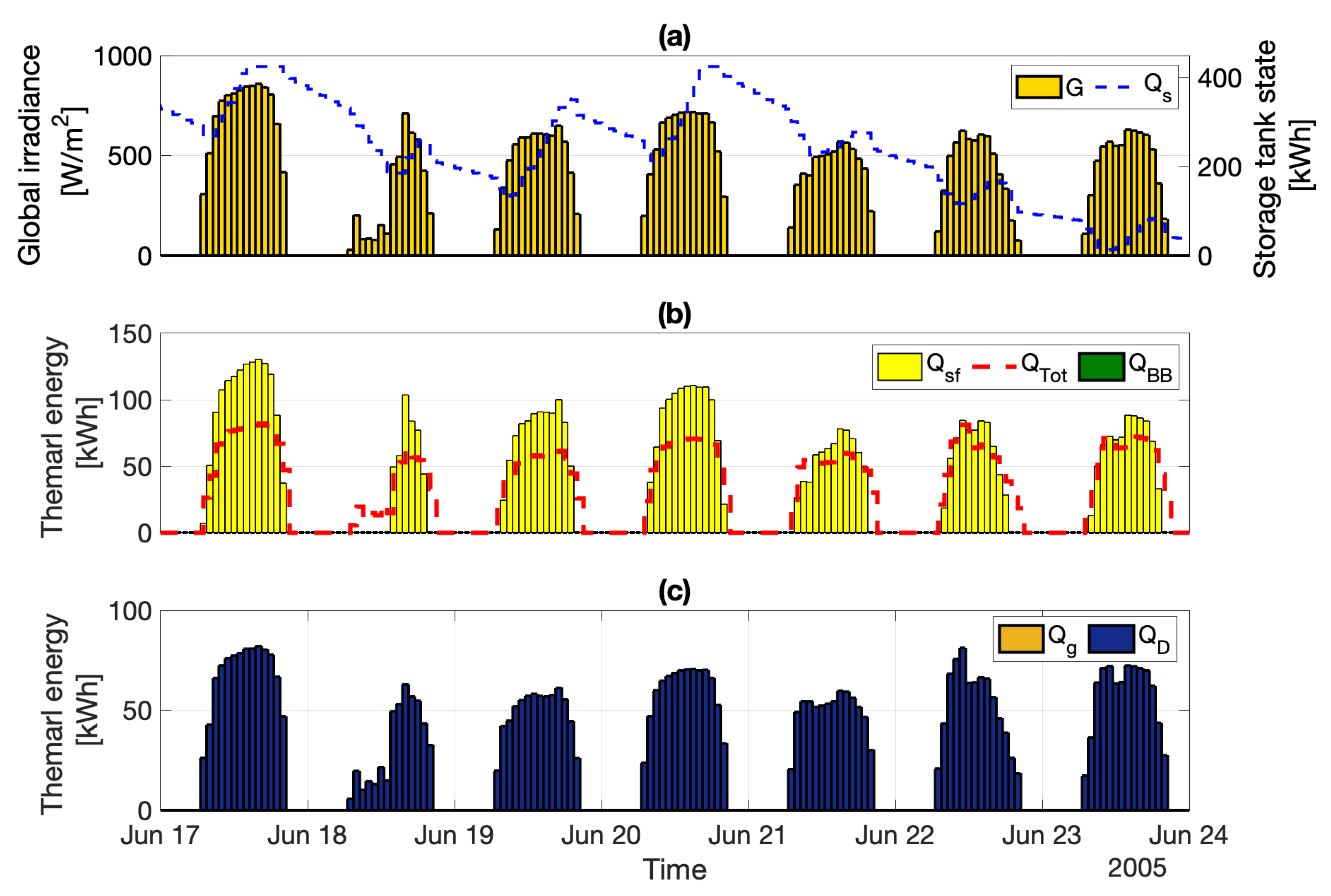
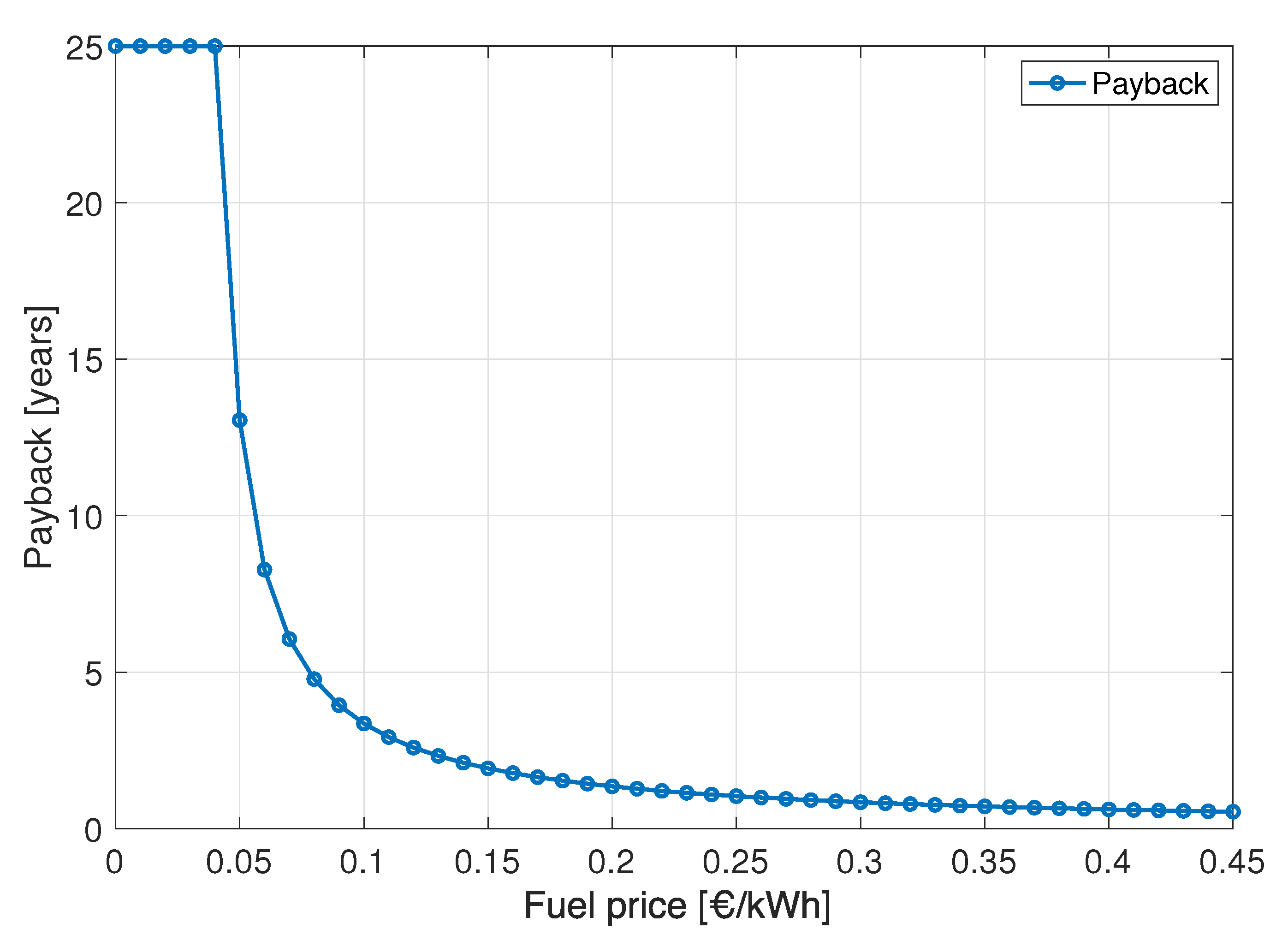
| ηb1 [-] | HV 2 [kWh/kg] | ηo3 [-] | α3 [W/(m2K)] | β3 [W/(m2K3)] | ηs4 [-] | ηch4 [-] | ηdis4 [-] | ηss5 [-] | STEC 6 [kWh/m3] | |
|---|---|---|---|---|---|---|---|---|---|---|
| Value | 0.8 | 4.86 | 0.775 | 3.723 | 0.016 | 0.95 | 0.98 | 0.98 | 1.2 | 106.6 |
| Lower Bound, | Upper Bound, | |
|---|---|---|
| 0 | 10,000 | |
| 0 | 6000 | |
| 0 | 10,000 |
| Optimal Sizing Parameters | Performance Metrics | |||||
|---|---|---|---|---|---|---|
| SF | BF | BPUI | ||||
| [m] | [kW] | [kWh] | [-] | [-] | [-] | |
| Value | 266 | 4234 | 425 | 0.16 | 0.84 | 5.25 |
| Cost/Unit | [€] | r | N [Years] | |||
|---|---|---|---|---|---|---|
| Solar field | 200 €/m | 53,200 | 0.009 kW/m | 0.5% e of | 3% | 25 |
| Biomass boiler | Power law rule | 491,860 | 0.225 €/kg | |||
| Thermal storage tank | 62 €/kW | 26,350 | - |
Publisher’s Note: MDPI stays neutral with regard to jurisdictional claims in published maps and institutional affiliations. |
© 2021 by the authors. Licensee MDPI, Basel, Switzerland. This article is an open access article distributed under the terms and conditions of the Creative Commons Attribution (CC BY) license (https://creativecommons.org/licenses/by/4.0/).
Share and Cite
Gil, J.D.; Ramos-Teodoro, J.; Romero-Ramos, J.A.; Escobar, R.; Cardemil, J.M.; Giagnocavo, C.; Pérez, M. Demand-Side Optimal Sizing of a Solar Energy–Biomass Hybrid System for Isolated Greenhouse Environments: Methodology and Application Example. Energies 2021, 14, 3724. https://doi.org/10.3390/en14133724
Gil JD, Ramos-Teodoro J, Romero-Ramos JA, Escobar R, Cardemil JM, Giagnocavo C, Pérez M. Demand-Side Optimal Sizing of a Solar Energy–Biomass Hybrid System for Isolated Greenhouse Environments: Methodology and Application Example. Energies. 2021; 14(13):3724. https://doi.org/10.3390/en14133724
Chicago/Turabian StyleGil, Juan D., Jerónimo Ramos-Teodoro, José A. Romero-Ramos, Rodrigo Escobar, José M. Cardemil, Cynthia Giagnocavo, and Manuel Pérez. 2021. "Demand-Side Optimal Sizing of a Solar Energy–Biomass Hybrid System for Isolated Greenhouse Environments: Methodology and Application Example" Energies 14, no. 13: 3724. https://doi.org/10.3390/en14133724
APA StyleGil, J. D., Ramos-Teodoro, J., Romero-Ramos, J. A., Escobar, R., Cardemil, J. M., Giagnocavo, C., & Pérez, M. (2021). Demand-Side Optimal Sizing of a Solar Energy–Biomass Hybrid System for Isolated Greenhouse Environments: Methodology and Application Example. Energies, 14(13), 3724. https://doi.org/10.3390/en14133724












